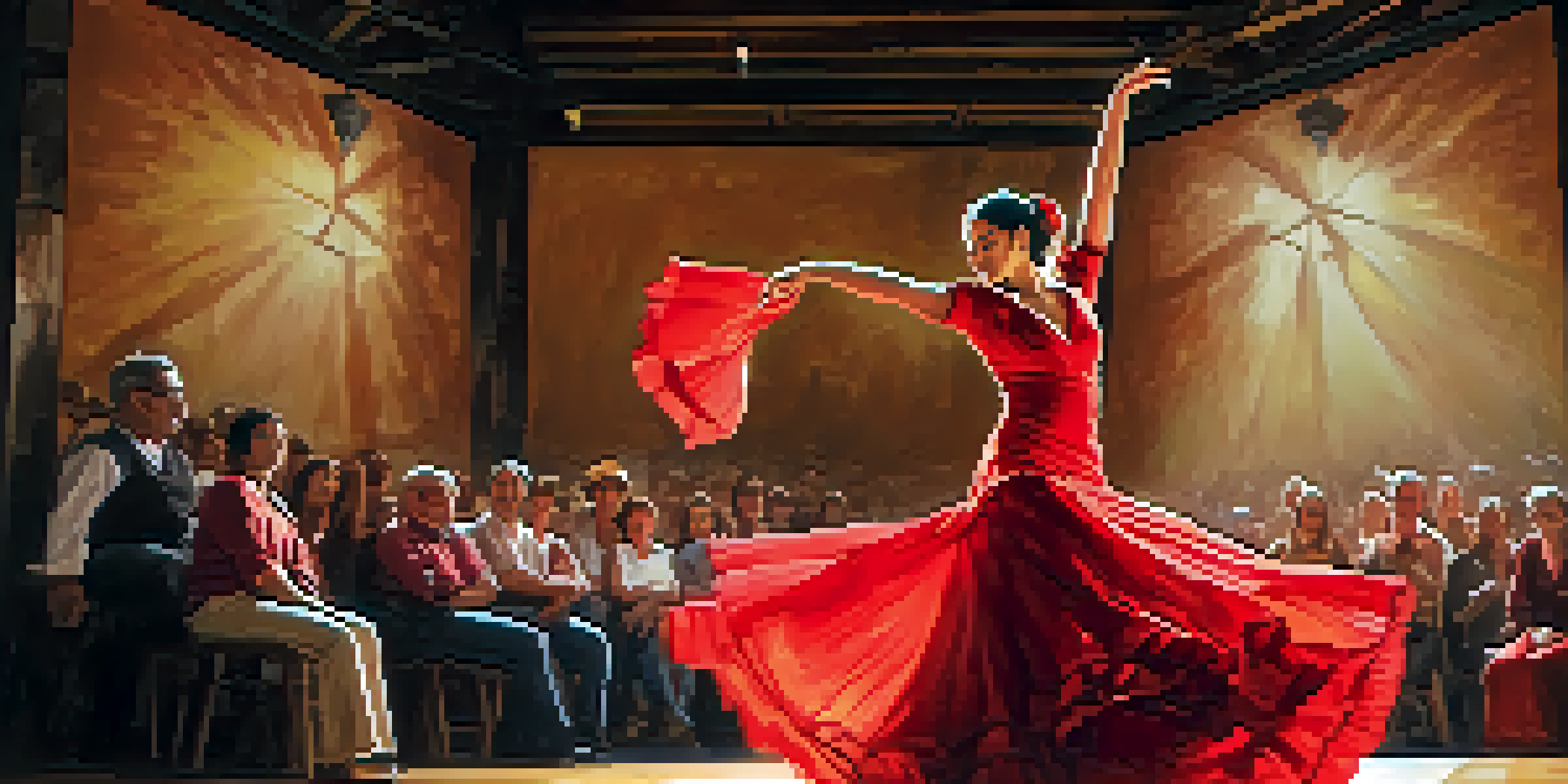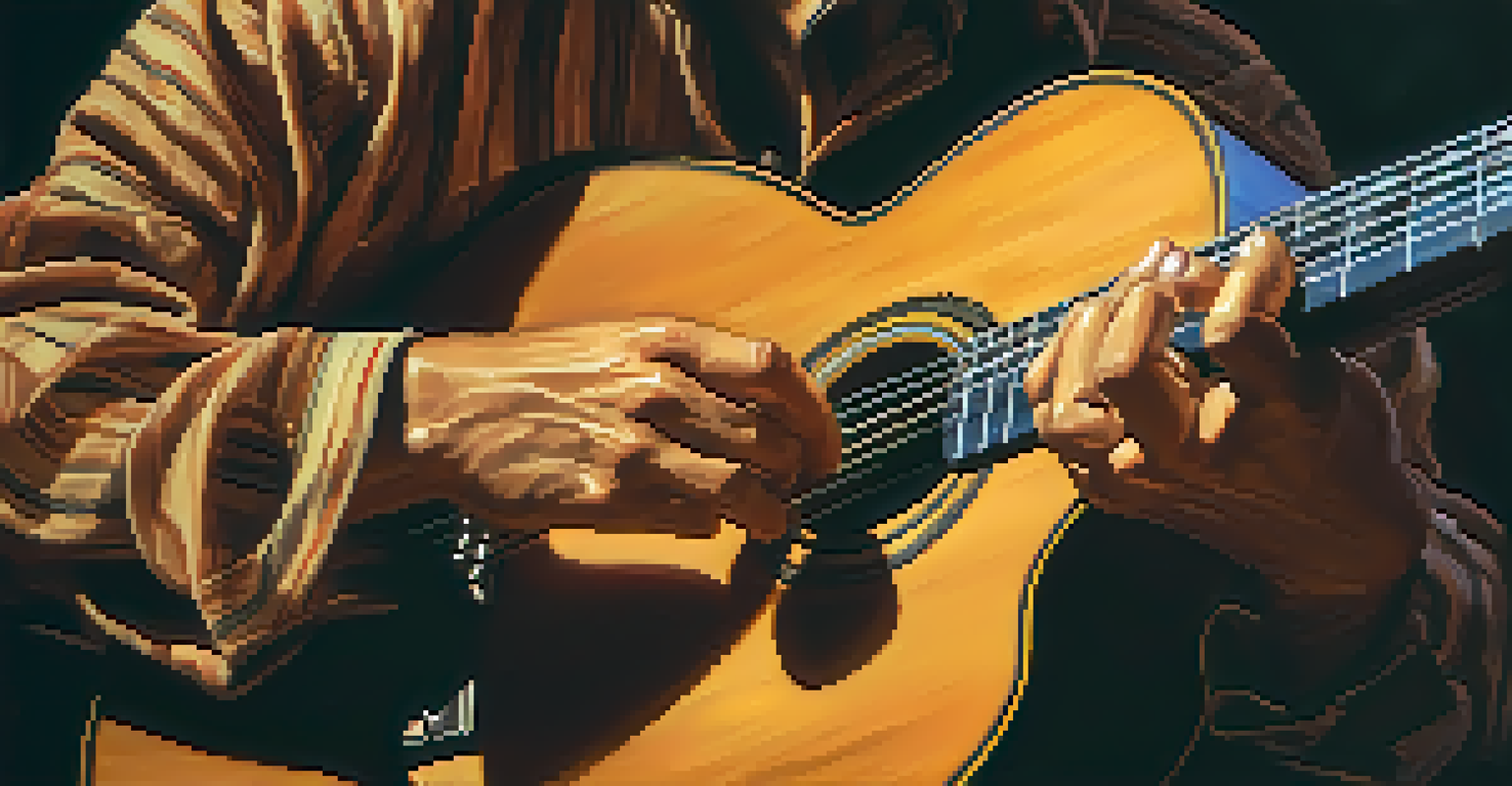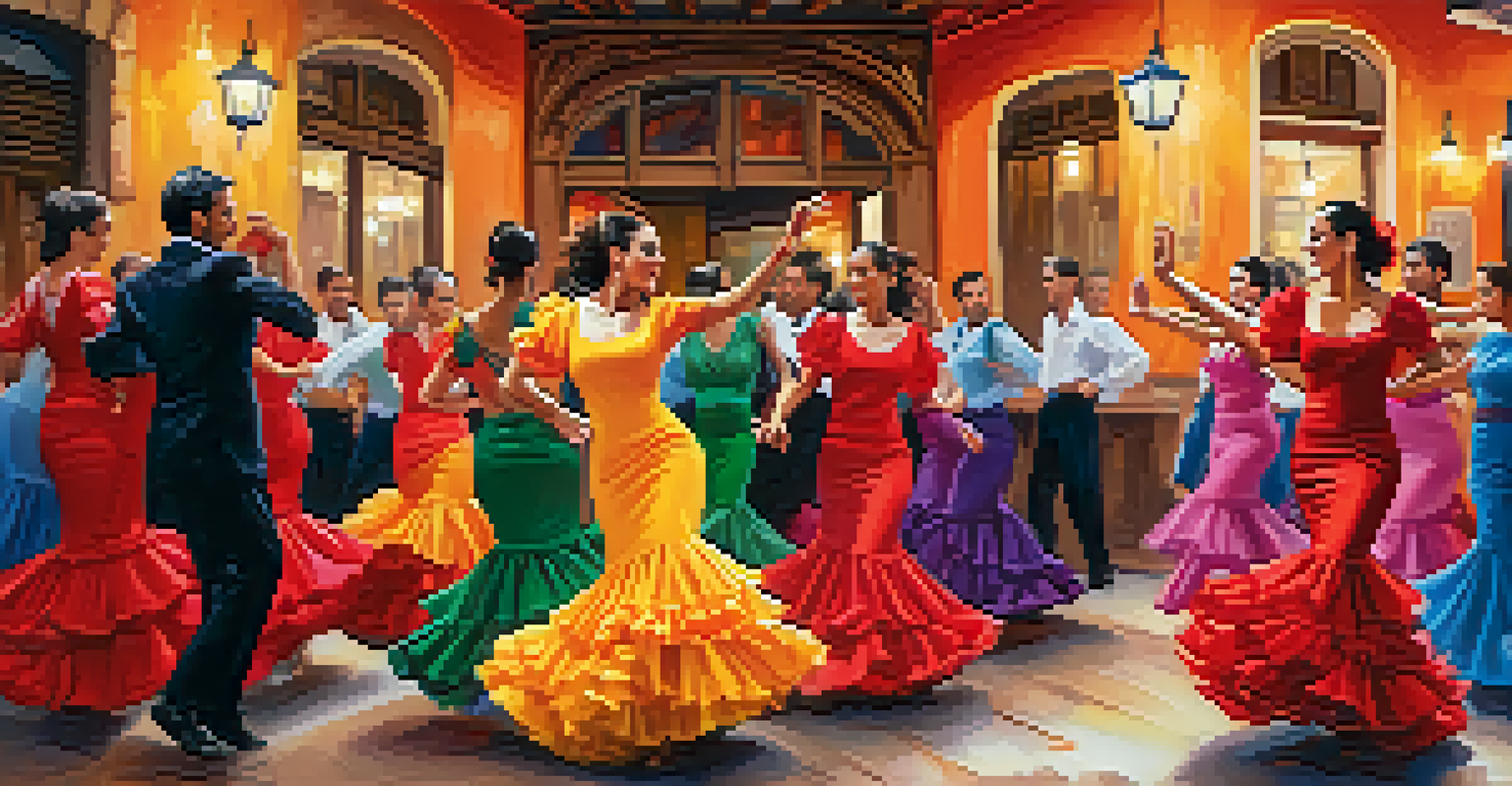The Evolution of Flamenco: From Folk Roots to Global Fame

The Humble Beginnings of Flamenco in Andalusia
Flamenco's roots run deep in the heart of Andalusia, Spain, where it began as a form of expression among marginalized communities. Originating in the 18th century, it blended various cultural influences, including Gypsy, Moorish, and Jewish traditions. This rich tapestry of backgrounds created a unique sound that resonated with the struggles and joys of everyday life.
Flamenco is a dance that speaks, a song that moves, and a story that inspires.
Initially, Flamenco was more than just music; it was a way for people to tell their stories, often in the form of heartfelt ballads. The passion and emotion embedded in these early performances laid the groundwork for what Flamenco would eventually become. As it evolved, the raw energy of these folk roots remained a cornerstone of the art form.
Today, the essence of those early performances is still felt in Flamenco, as artists strive to honor their heritage while pushing creative boundaries. It's a beautiful reminder of how music can serve as both a personal and collective narrative, connecting generations through shared experiences.
The Key Elements: Music, Dance, and Song
At its core, Flamenco is a powerful fusion of three key elements: guitar, dance, and singing. Each component plays a crucial role in conveying the deep emotions associated with the art form. The guitar provides a rhythmic foundation, while the singer's voice delivers poignant lyrics, often reflecting themes of love, loss, and longing.

The dance, characterized by intricate footwork and passionate movements, adds a visual dimension to the storytelling. Dancers express the music's rhythm and emotion through their bodies, making every performance a captivating experience. Together, these elements create a dynamic interplay that captivates audiences, drawing them into the world of Flamenco.
Flamenco's Rich Cultural Roots
Flamenco originated in 18th century Andalusia, blending influences from marginalized communities, including Gypsy, Moorish, and Jewish traditions.
While these components are traditional, modern Flamenco has embraced innovation, incorporating contemporary styles and instruments. This evolution keeps the art form alive and relevant, allowing it to resonate with new audiences while still honoring its historical roots.
The Influence of the Gypsy Culture
The Romani people, often referred to as Gypsies, have had a profound impact on the development of Flamenco. Their unique musical traditions and expressive dance forms significantly shaped the genre, infusing it with a sense of freedom and intensity. This cultural exchange not only enriched Flamenco but also highlighted the struggles and resilience of the Romani community.
Music is the universal language of mankind.
As Flamenco gained popularity, it became a means of cultural identity for the Gypsies, allowing them to express their heritage and experiences. The emphasis on improvisation in Flamenco can be traced back to Gypsy traditions, where performers would often adapt their art to reflect their personal stories and emotions.
Today, the influence of Gypsy culture remains evident in Flamenco performances around the world. While the art form has expanded beyond its original community, the spirit of these early contributors continues to inspire artists and audiences alike, reminding us of the importance of cultural roots.
Flamenco's Journey: From Local to Global
In the late 19th and early 20th centuries, Flamenco began to capture the attention of broader audiences, moving from local taverns and gatherings to larger venues. This shift was fueled by the rise of cafés cantantes, or singing cafes, where artists showcased their talents to the public. This newfound exposure helped elevate Flamenco from a regional folk art to a respected performance genre.
As the 20th century progressed, Flamenco artists began touring internationally, bringing their passion and artistry to the global stage. The allure of Flamenco captured the hearts of diverse audiences, leading to collaborations with various musical genres and artists around the world. This exchange of ideas enriched the art form, allowing it to evolve while still retaining its core essence.
Evolution through Innovation
Modern Flamenco artists are fusing traditional elements with contemporary genres, allowing the art form to remain relevant and appealing to new audiences.
Today, Flamenco is celebrated worldwide, with festivals and competitions dedicated to this vibrant art form. It's fascinating to see how a genre that began in the shadows has transformed into a symbol of cultural pride and artistic expression on a global scale.
Modern Innovations: Fusing Flamenco with Other Genres
As Flamenco continues to evolve, many artists are experimenting by blending it with other musical genres, creating innovative fusions that attract new audiences. Collaborations with jazz, rock, and even electronic music have resulted in exciting new sounds, allowing Flamenco to reach beyond its traditional boundaries. These modern interpretations showcase the versatility of Flamenco while appealing to a younger demographic.
One notable example is the collaboration between Flamenco guitarists and world music artists, which has led to the birth of entirely new genres. This cross-pollination of styles not only enriches the musical landscape but also demonstrates the adaptability of Flamenco in a rapidly changing world. Artists are now free to explore their creativity without being confined to traditional frameworks.
While these innovations are thrilling, they also raise questions about authenticity and preservation. Striking a balance between honoring the roots of Flamenco and embracing modern influences is crucial for the future of this beautiful art form. The challenge lies in staying true to its essence while inviting new voices and perspectives into the conversation.
The Role of Women in Flamenco's Evolution
Women have played a pivotal role in the evolution of Flamenco, both as performers and as influential figures in its history. Historically, female flamenco dancers, known as 'bailaores,' brought a unique grace and powerful presence to the stage. Their contributions helped elevate the status of Flamenco, proving that it was an art form worthy of respect and admiration.
In recent years, female artists have emerged as key innovators in the Flamenco scene, challenging traditional norms and exploring new themes. They use their platforms to address social issues, personal experiences, and cultural narratives, bringing fresh perspectives to the art form. This shift has not only broadened the scope of Flamenco but has also inspired a new generation of female artists.
Women Empowering Flamenco's Future
Women have historically been pivotal in Flamenco's evolution and continue to challenge norms, bringing fresh perspectives and themes to the art form.
The celebration of women in Flamenco is evident in festivals and performances, where their artistry takes center stage. As we witness this evolution, it's exciting to see how women's voices continue to shape the future of Flamenco, ensuring its relevance and vitality in a changing world.
Flamenco in the Digital Age: Challenges and Opportunities
As we enter the digital age, Flamenco faces both challenges and opportunities in reaching new audiences. On one hand, the internet has allowed artists to share their work with a global audience, expanding the reach of Flamenco beyond traditional borders. Social media platforms like Instagram and YouTube have become essential tools for promoting performances and connecting with fans around the world.
However, this digital landscape also presents challenges, such as maintaining authenticity amid the rapid spread of content. With so many interpretations of Flamenco available online, it can be difficult for audiences to discern genuine artistry from superficial imitations. Artists must navigate this environment carefully, ensuring they stay true to their roots while embracing the advantages of technology.

Ultimately, the digital age offers a unique opportunity for Flamenco to thrive and evolve. By harnessing the power of online platforms, artists can reach diverse audiences, create meaningful connections, and cultivate a vibrant global community. As Flamenco continues to adapt, its legacy is poised to endure, inspiring future generations to keep the flame alive.